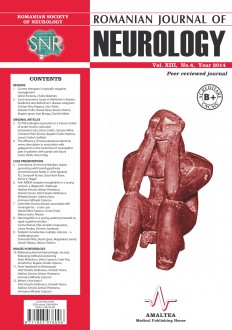SELECT ISSUE

Indexed

| |

|
|
|
| |
|
|
|

|
|
|
|
|
|
| |
|
|
HIGHLIGHTS
National Awards “Science and Research”
NEW! RJN has announced the annually National Award for "Science and Research" for the best scientific articles published throughout the year in the official journal.
Read the Recommendations for the Conduct, Reporting, Editing, and Publication of Scholarly work in Medical Journals.
The published medical research literature is a global public good. Medical journal editors have a social responsibility to promote global health by publishing, whenever possible, research that furthers health worldwide.
ANTI-NMDA-RECEPTOR ENCEPHALITIS IN A YOUNG WOMEN: A DIAGNOSTIC CHALLENGE
Adelina Simona Serban-Pereteanu, Daniela Trasca, Vlad Claudiu Stefanescu, Mihaela Bustan, Sabina Zurac and Inimioara Mihaela Cojocaru
ABSTRACT
A 42-year-old women is admitted in the Psychiatric Department with signs of acute psychosis. She had orolinguofacial dyskinesias, episodes of bilateral rigidity, oculocephalogyric crisis and becomes stuporous. The cerebral MRI highlighted two supratentorial demielination lesions. The CSF examination shows clear CSF with moderate pleocitosis and the predominance lymphocyte. Viral and bacterial cultures were negative. The patient is transferred to our Department of Neurology after 5 days, and runs a fever. Also, orolinguofacial dyskinesias, hypersalivation, puppet’s eye syndrome, swallowing disorders, bilateral jerks osteotendinous reflexes, and coma state (GCS=5) are present. A second cerebral MRI was performed, which suggested two hypersignal lesions, T2, FLAIR and T1 hyposignal present, with no diffusion restriction, one being 0.9 cm, situated subcortically and to the right, the other of 0.5 cm being located on the left subcortical parietal, without gadolinium enhancement. The native pelvic CT scan marked out a 4.9 cm left annex cyst present. Anti-NMDAR antibodies were present in the CSF. As the patient was comatose, an interventional genital procedure is contraindicated. The patient was given iv Immunoglobulis, Methylprednisolone, Cyclophosphamide, anticonvulsives, and large spectrum antibiotics. She manifested multiple oculocephalogyric crisis, in both directions, bronchopneumonia, respiratory failure, requiring mechanical ventilatory support. The patient dies three weeks after the onset of the symptoms. The pathological examination revealed a left mature ovarian teratoma. The anti-NMDAR encephalitis is a life-threatening condition consisting of memory and psychiatric disorder, alteration of consciousness and hypoventilation, common associated with ovarian teratomas. The fast diagnosis and an early specific treatment can strongly influence the antiNMDAR encephalitis’s natural evolution.
Keywords: Anti-N-methyl-D-aspartate-receptor (NMDAR) encephalitis, autoimmune encephalitis, paraneoplastic syndrome, ovarian teratoma
Full text | PDF
